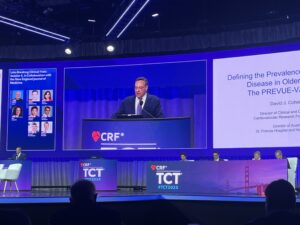
A “site-less” trial that recruited subjects at pharmacies across the USA to screen for valvular heart disease suggests that there are several million adults aged between 65-85 across the country living with significant, undiagnosed aortic, mitral or tricuspid valve disease.
Results from the PREVUE-VALVE study, presented by David J Cohen (St Francis Hospital and Heart Center, Roslyn, USA) at the 2025 Transcatheter Cardiovascular Therapeutics (TCT) conference (25–28 October, San Francisco, USA) suggest that there are currently at least 4.7 million older adults living with moderate or greater valvular heart disease in the USA, and at least 10.6 million with clinically significant valvular disease, most of whom are unaware of their condition. The prevalence of valve disease increases sharply with advanced age.
Patients were enrolled at for the study at pharmacies throughout the USA. After an initial screening, a total of 3,000 people received an at-home visit during which a 12-lead electrocardiogram and a formal echocardiogram were performed. Blood samples (upon patient consent) and standardised health status assessments were also collected. Electrocardiogram and echocardiogram assessments (including diagnosis and assessment of severity of valvular heart disease) were performed by independent core laboratories.
The primary endpoint was the population prevalence of moderate or greater valvular heart disease and its individual components including aortic stenosis, aortic regurgitation, mitral stenosis, mitral regurgitation or tricuspid regurgitation.
The study found that the overall prevalence of moderate or greater valvular disease was 8.2%. The prevalence increased with advanced age (5.1% in patients 65–69, 7% for 70–74, 10.5% for 75–79 and 14.7% for 80–85 years of age). Tricuspid regurgitation (3.7%) was the most common type of valvular disease followed by aortic stenosis (3.1%), mitral regurgitation (2%) and aortic regurgitation (0.7%).
When study participants with mild to moderate valvular disease were also included, the overall prevalence increased to 18.4% with the rate also increasing with age (31.4% in the 80–85 cohort compared with 12.1% for 65–69 years of age).
Tricuspid regurgitation was the most common type valvular disease (10.7%) when including mid-moderate disease. A further analysis using census data from the USA suggested that at least 4.7 million people between the ages of 65–85 are living with moderate or greater valvular disease, and at least 10.6 million have greater than mild disease. Based on current census projections, the absolute prevalence of moderate or greater valvular disease is projected to increase by about 1.8 million by 2060, driven largely by a 74% increase among the 80–85-year-old age group.
The study also found that age-adjusted and sex-adjusted prevalence of valvular disesae is approximately 20% lower among Black versus White individuals in the USA, driven largely by lower rates of aortic valve disease.
“Many patients with valvular heart disease remain untreated due to inadequate access to appropriate care or are treated later than recommended due to a late diagnosis,” said Cohen. “These findings clearly show that the prevalence of these conditions is substantial and will continue to grow over the next several decades as the population continues to age. In addition, they have important public health implications that should inform the design of future studies to help us develop tools to more effectively screen and diagnose patients with VHD and ultimately ensure broad access to treatment.”
The study was an investigator-initiated study sponsored by the Cardiovascular Research Foundation funded by investigator-initiated grants from Abbott, Edwards Lifesciences, and Philips.











